Bell UH-1 Iroquois

Bell UH-1 Iroquois

| UH-1 Iroquois / HU-1 "Huey" | |
|---|---|
| A Bell UH-1 Iroquois | |
| Role | Utility helicopter |
| National origin | United States |
| Manufacturer | Bell Helicopter |
| First flight | 20 October 1956 (XH-40) |
| Introduction | 1959 |
| Status | In service |
| Primary users | United States Army (historical) Japan Ground Self-Defense Force Australian Army (historical) See Operators section for others |
| Produced | 1956–1987 |
| Number built | 16,000 |
| Variants | Bell UH-1N Twin Huey Bell 204/205 Bell 212 |
| Developed into | Bell AH-1 Cobra Bell 214 |
The Bell UH-1 Iroquois (nicknamed "Huey") is a utility military helicopter powered by a single turboshaft engine, with two-blade main and tail rotors. The first member of the prolific Huey family, it was developed by Bell Helicopter to meet a United States Army's 1952 requirement for a medical evacuation and utility helicopter, and first flew in 1956. The UH-1 was the first turbine-powered helicopter produced for the United States military, and more than 16,000 have been built since 1960.[5]
The Iroquois was originally designated HU-1, hence the Huey nickname, which has remained in common use, despite the official redesignation to UH-1 in 1962.[6] The UH-1 first saw service in combat operations during the Vietnam War, with around 7,000 helicopters deployed. The Bell 204 and 205 are Iroquois versions developed for the civil market.
| UH-1 Iroquois / HU-1 "Huey" | |
|---|---|
| A Bell UH-1 Iroquois | |
| Role | Utility helicopter |
| National origin | United States |
| Manufacturer | Bell Helicopter |
| First flight | 20 October 1956 (XH-40) |
| Introduction | 1959 |
| Status | In service |
| Primary users | United States Army (historical) Japan Ground Self-Defense Force Australian Army (historical) See Operators section for others |
| Produced | 1956–1987 |
| Number built | 16,000 |
| Variants | Bell UH-1N Twin Huey Bell 204/205 Bell 212 |
| Developed into | Bell AH-1 Cobra Bell 214 |
Development
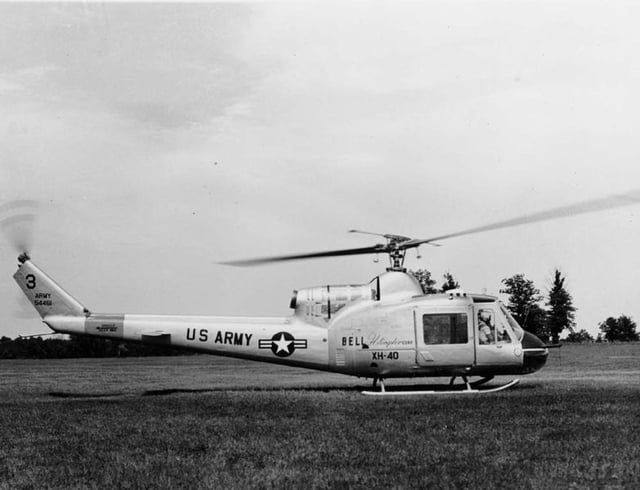
A Bell XH-40, a prototype of the UH-1
In 1952, the U.S. Army identified a requirement for a new helicopter to serve as medical evacuation (MEDEVAC), instrument trainer, and general utility aircraft. The Army determined that current helicopters were too large, underpowered, or too complex to maintain easily. In November 1953, revised military requirements were submitted to the Department of the Army.[7] Twenty companies submitted designs in their bid for the contract, including Bell Helicopter with the Model 204 and Kaman Aircraft with a turbine-powered version of the H-43. On 23 February 1955, the Army announced its decision, selecting Bell to build three copies of the Model 204 for evaluation with the designation XH-40.[8]
Model 204
Powered by a prototype Lycoming YT53-L-1 (LTC1B-1) engine producing 700 shp (520 kW), the XH-40 first flew on 20 October 1956[9] at Fort Worth, Texas, with Bell's chief test pilot, Floyd Carlson, at the controls. Two more prototypes were built in 1957, and the Army had previously ordered six YH-40 service test aircraft, even before the first prototype had flown.[7][10] In March 1960, the Army awarded Bell a production contract for 100 aircraft, which was designated "HU-1A" and officially named Iroquois after the Native American nations.[11]
The helicopter quickly developed a nickname derived from its HU-1 designation, which came to be pronounced as "Huey". The reference became so popular that Bell began casting the name on the helicopter's anti-torque pedals.[6] The official U.S. Army name was almost never used in practice.[12] After September 1962, the designation for all models was changed to UH-1 under a unified Department of Defense (DOD) designation system, but the nickname remained.
While glowing in praise for the helicopter's advances over piston-engined helicopters, the Army reports from the service tests of the YH-40 found it to be underpowered with the production T53-L-1A powerplant producing a maximum continuous 770 shaft horsepower (570 kilowatts).[1] The Army indicated the need for improved follow-on models even as the first UH-1As were being delivered. In response, Bell proposed the UH-1B, equipped with the Lycoming T53-L-5 engine producing 960 shp (720 kW) and a longer cabin that could accommodate either seven passengers or four stretchers and a medical attendant. Army testing of the UH-1B started in November 1960, with the first production aircraft delivered in March 1961.[7]
Bell commenced development of the UH-1C in 1960 in order to correct aerodynamic deficiencies of the armed UH-1B. Bell fitted the UH-1C with a 1,100 shp (820 kW) T53-L-11 engine to provide the power needed to lift all weapons systems in use or under development. The Army eventually refitted all UH-1B aircraft with the same engine. A new rotor system was developed for the UH-1C to allow higher air speeds and reduce the incidence of retreating blade stall during diving engagements. The improved rotor resulted in better maneuverability and a slight speed increase.[10] The increased power and a larger diameter rotor required Bell's engineers to design a new tail boom for the UH-1C. The longer tail boom incorporated a wider chord vertical fin on the tail rotor pylon and larger synchronized elevators.
Bell also introduced a dual hydraulic control system for redundancy as well as an improved inlet filter system for the dusty conditions found in southeast Asia. The UH-1C fuel capacity was increased to 242 US gallons (920 liters), and gross weight was raised to 9,500 lb (4,309 kg), giving a nominal useful load of 4,673 lb (2,120 kg). UH-1C production started in June 1966 with a total of 766 aircraft produced, including five for the Royal Australian Navy and five for Norway.
Model 205
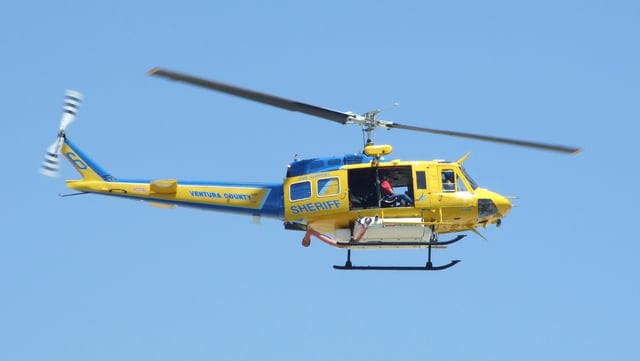
Ventura County Sheriff's Department Air Unit Fire Support Bell HH-1H
While earlier "short-body" Hueys were a success, the Army wanted a version that could carry more troops. Bell's solution was to stretch the HU-1B fuselage by 41 in (104 cm) and use the extra space to fit four seats next to the transmission, facing out. Seating capacity increased to 15, including crew.[13] The enlarged cabin could also accommodate six stretchers and a medic, two more than the earlier models.[13] In place of the earlier model's sliding side doors with a single window, larger doors were fitted which had two windows, plus a small hinged panel with an optional window, providing enhanced access to the cabin. The doors and hinged panels were quickly removable, allowing the Huey to be flown in a "doors off" configuration.
The Model 205 prototype flew on 16 August 1961.[14][15] Seven pre-production/prototype aircraft had been delivered for testing at Edwards AFB starting in March 1961. The 205 was initially equipped with a 44-foot (13.4 m) main rotor and a Lycoming T53-L-9 engine with 1,100 shp (820 kW). The rotor was lengthened to 48 feet (14.6 m) with a chord of 21 in (53 cm). The tailboom was also lengthened, in order to accommodate the longer rotor blades. Altogether, the modifications resulted in a gross weight capacity of 9,500 lb (4,309 kg). The Army ordered production of the 205 in 1963, produced with a T53-L-11 engine for its multi-fuel capability.[2][16] The prototypes were designated as YUH-1D and the production aircraft was designated as the UH-1D.
Marine Corps
In 1962, the United States Marine Corps held a competition to choose an assault support helicopter to replace the Cessna O-1 fixed-wing aircraft and the Kaman OH-43D helicopter. The winner was the UH-1B, which was already in service with the Army. The helicopter was designated the UH-1E and modified to meet Marine requirements. The major changes included the use of all-aluminum construction for corrosion resistance,[3] radios compatible with Marine Corps ground frequencies, a rotor brake for shipboard use to stop the rotor quickly on shutdown and a roof-mounted rescue hoist.
The UH-1E was first flown on 7 October 1963, and deliveries commenced 21 February 1964, with 192 aircraft completed. Due to production line realities at Bell, the UH-1E was produced in two different versions, both with the same UH-1E designation. The first 34 built were essentially UH-1B airframes with the Lycoming T53-L-11 engine producing 1,100 shp (820 kW). When Bell switched production to the UH-1C, the UH-1E production benefited from the same changes. The Marine Corps later upgraded UH-1E engines to the Lycoming T53-L-13, which produced 1,400 shp (1,000 kW), after the Army introduced the UH-1M and upgraded their UH-1C helicopters to the same engine.
Air Force
The United States Air Force's (USAF) competition for a helicopter to be used for support on missile bases included a specific requirement to mandate the use of the General Electric T58 turboshaft as a powerplant. The Air Force had a large inventory of these engines on hand for its fleet of HH-3 Jolly Green Giant rescue helicopters and using the same engine for both helicopters would save costs. In response, Bell proposed an upgraded version of the 204B with the T58 engine. Because the T58 output shaft is at the rear, and was thus mounted in front of the transmission on the HH-3, it had to have a separate offset gearbox (SDG or speed decreaser gearbox) at the rear, and shafting to couple to the UH-1 transmission.
Twin–engine variants
The single–engine UH-1 variants were followed by the twin-engine UH-1N Twin Huey and years later the UH-1Y Venom. Bell began development of the UH-1N for Canada in 1968. It changed to the more powerful Pratt & Whitney Canada PT6T twin-engine set. The U.S. also ordered the helicopter with the U.S. Air Force receiving it in 1970. Canada's military, the U.S. Marine Corps, and the U.S. Navy first received the model in 1971.[18]
In 1996, the USMC began the H-1 upgrade program by awarding a contract to Bell Helicopter for developing the improved UH-1Y and AH-1Zs variants.[19] The UH-1Y includes a lengthened cabin, four-blade rotor, and two more powerful GE T700 engines.[5] The UH-1Y entered service with the USMC in 2008.[20]
Design
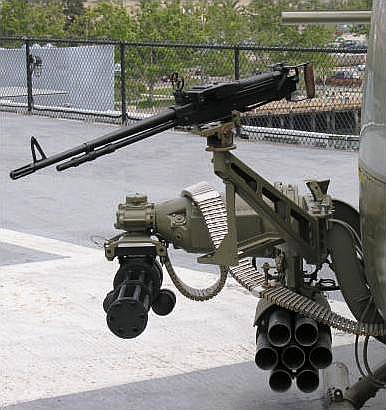
Typical armament for UH-1 gunship
The UH-1 has a metal fuselage of semi-monocoque construction with tubular landing skids and two rotor blades on the main rotor.[21] Early UH-1 models featured a single Lycoming T53 turboshaft engine in versions with power ratings from 700 shp (522 kW) to 1,400 shp (1,040 kW).[10] Later UH-1 and related models featured twin engines and four-blade rotors.
All aircraft in the UH-1 family have similar construction. The UH-1H is the most-produced version, and is representative of all types. The main structure consists of two longitudinal main beams that run under the passenger cabin to the nose and back to the tail boom attachment point. The main beams are separated by transverse bulkheads and provide the supporting structure for the cabin, landing gear, under-floor fuel tanks, transmission, engine and tail boom. The main beams are joined at the lift beam, a short aluminum girder structure that is attached to the transmission via a lift link on the top and the cargo hook on the bottom and is located at the aircraft's center of gravity. The lift beams were changed to steel later in the UH-1H's life, due to cracking on high-time airframes. The semi-monocoque tail boom attaches to the fuselage with four bolts.[22]
The UH-1H's dynamic components include the engine, transmission, rotor mast, main rotor blades, tail rotor driveshaft, and the 42-degree and 90-degree gearboxes. The transmission is of a planetary type and reduces the engine's output to 324 rpm at the main rotor. The two-bladed, semi-rigid rotor design, with pre-coned and underslung blades, is a development of early Bell model designs, such as the Bell 47 with which it shares common design features, including a damped stabilizer bar. The two-bladed system reduces storage space required for the aircraft, but at a cost of higher vibration levels. The two-bladed design is also responsible for the characteristic 'Huey thump' when the aircraft is in flight, which is particularly evident during descent and in turning flight. The tail rotor is driven from the main transmission, via the two directional gearboxes which provide a tail rotor speed approximately six times that of the main rotor to increase tail rotor effectiveness.[22]
The UH-1H also features a synchronized elevator on the tail boom, which is linked to the cyclic control and allows a wider center of gravity range. The standard fuel system consists of five interconnected fuel tanks, three of which are mounted behind the transmission and two of which are under the cabin floor. The landing gear consists of two arched cross tubes joining the skid tubes. The skids have replaceable sacrificial skid shoes to prevent wear of the skid tubes themselves. Skis and inflatable floats may be fitted.[22]
Internal seating is made up of two pilot seats and additional seating for up to 13 passengers or crew in the cabin. The maximum seating arrangement consists of a four-man bench seat facing rearwards behind the pilot seats, facing a five-man bench seat in front of the transmission structure, with two, two-man bench seats facing outwards from the transmission structure on either side of the aircraft. All passenger seats are constructed of aluminum tube frames with canvas material seats, and are quickly removable and reconfigurable. The cabin may also be configured with up to six stretchers, an internal rescue hoist, auxiliary fuel tanks, spotlights, or many other mission kits. Access to the cabin is via two aft-sliding doors and two small, forward-hinged panels. The doors and hinged panels may be removed for flight or the doors may be pinned open. Pilot access is via individual hinged doors.[22]
While the five main fuel tanks are self-sealing, the UH-1H was not equipped with factory armor, although armored pilot seats were available.[22]
The UH-1H's dual controls are conventional for a helicopter and consist of a single hydraulic system boosting the cyclic stick, collective lever and anti-torque pedals. The collective levers have integral throttles, although these are not used to control rotor rpm, which is automatically governed, but are used for starting and shutting down the engine. The cyclic and collective control the main rotor pitch through push-pull tube linkages to the swashplate, while the anti-torque pedals change the pitch of the tail rotor via a tensioned cable arrangement. Some UH-1Hs have been modified to replace the tail rotor control cables with push-pull tubes similar to the UH-1N Twin Huey.[22]
Operational history
U.S. Army
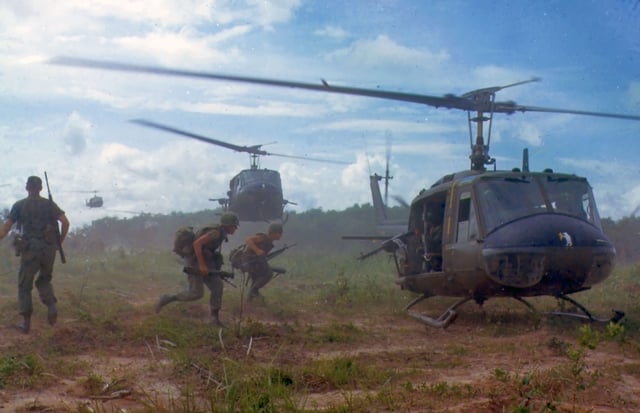
UH-1Ds airlift members of the 2nd Battalion, 14th Infantry Regiment from the Filhol Rubber Plantation area to a staging area in 1966.
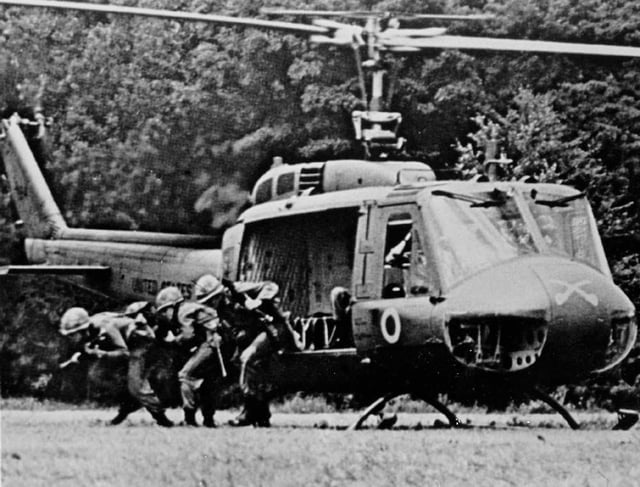
A rifle squad from the 1st Squadron, 9th Cavalry exiting from a UH-1D.
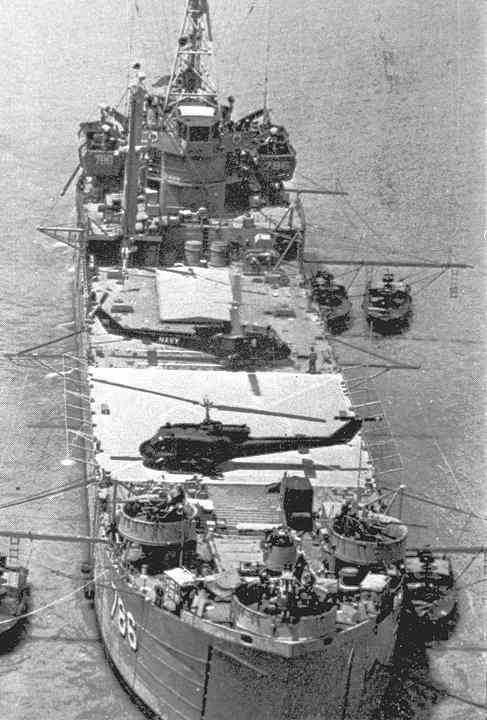
Two UH-1B Huey gunships from HAL-3 "Seawolf" sit on the deck of USS Garrett County in Mekong Delta, South Vietnam.
The HU-1A (later redesignated UH-1A) first entered service with the 101st Airborne Division at Fort Campbell, Kentucky, the 82nd Airborne Division, and the 57th Medical Detachment. Although intended for evaluation only, the Army quickly pressed the new helicopter into operational service, and Hueys with the 57th Medical Detachment arrived in Vietnam in March 1962.[17] The UH-1 has long been a symbol of US involvement in Southeast Asia in general and Vietnam in particular, and as a result of that conflict, has become one of the world's most recognized helicopters. In Vietnam primary missions included general support, air assault, cargo transport, aeromedical evacuation, search and rescue, electronic warfare, and later, ground attack. During the conflict, the craft was upgraded, notably to a larger version based on the Model 205. This version was initially designated the UH-1D and flew operationally from 1963.
During service in the Vietnam War, the UH-1 was used for various purposes and various terms for each task abounded. UH-1s tasked with ground attack or armed escort were outfitted with rocket launchers, grenade launchers, and machine guns. As early as 1962, UH-1s were modified locally by the companies themselves, who fabricated their own mounting systems.[23] These gunship UH-1s were commonly referred to as "Frogs" or "Hogs" if they carried rockets, and "Cobras" or simply "Guns" if they had guns.[24][25][4][26] UH-1s tasked and configured for troop transport were often called "Slicks" due to an absence of weapons pods. Slicks did have door gunners, but were generally employed in the troop transport and medevac roles.[12][17]
UH-1s also flew "hunter-killer" teams with observation helicopters, namely the Bell OH-58A Kiowa and the Hughes OH-6 Cayuse (Loach).[12][17] Towards the end of the conflict, the UH-1 was tested with TOW missiles, and two UH-1B helicopters equipped with the XM26 Armament Subsystem were deployed to help counter the 1972 Easter Invasion.[27] USAF Lieutenant James P. Fleming piloted a UH-1F on a 26 November 1968 mission that earned him the Medal of Honor.[28]
During the course of the war, the UH-1 went through several upgrades. The UH-1A, B, and C models (short fuselage, Bell 204) and the UH-1D and H models (stretched-fuselage, Bell 205) each had improved performance and load-carrying capabilities. The UH-1B and C performed the gunship, and some of the transport, duties in the early years of the Vietnam War. UH-1B/C gunships were replaced by the new AH-1 Cobra attack helicopter from 1967 to late 1968. The increasing intensity and sophistication of NVA anti-aircraft defenses made continued use of UH-1 gunships impractical, and after Vietnam the Cobra was adopted as the Army's main attack helicopter. Devotees of the UH-1 in the gunship role cite its ability to act as an impromptu Dustoff if the need arose, as well as the superior observational capabilities of the larger Huey cockpit, which allowed return fire from door gunners to the rear and sides of the aircraft.[12][17] In air cavalry troops (i.e., companies) UH-1s were combined with infantry scouts, OH-6 and OH-58 aero-scout helicopters, and AH-1 attack helicopters to form several color-coded teams (viz., blue, white, red, purple, and pink) to perform various reconnaissance, security, and "economy of force" missions in fulfilling the traditional cavalry battlefield role.
The Army tested a great variety of experimental weapons on the UH-1; nearly anything that could be carried. The Army desired weapons with large calibers and high rates of fire, which led to the testing of a 20 mm cannon on a large mount bolted to the cabin floor. The size of the weapon allowed very little room for movement. The Army further tested a full-size Vulcan cannon firing out the door of a UH-1. It was capable of firing 2400 rounds per minute, or about 40 rounds per second. Despite this being a significant reduction from the nearly 100 rounds per second fired by a standard Vulcan cannon, the installation proved "too kinetic" for the UH-1. Podded versions of the M24 20 mm cannon were tested in combat over Vietnam. There was a wide variety of 7.62 mm automatic weapons tested, including different installations of the M60 machine gun. AS-10 and SS-11 missiles were tested in several different configurations. High-capacity rocket launchers were also tested, such as the XM3 launcher, which had 24 launching tubes. Press photos were taken with the XM5 and XM3 installed on the same aircraft, but this arrangement could not be used because it was more than the gross take-off weight of the aircraft.[29]
During the 1972 Easter offensive by North Vietnam, experimental models of the TOW-firing XM26 were taken out of storage and sent to South Vietnam to help stop the onslaught. The pilots had never fired a TOW missile before, and were given just crash courses. Despite having little training with the units, the pilots managed to hit targets with 151 of the 162 missiles fired in combat, including a pair of tanks. The airborne TOW launchers were known as "Hawks Claws" and were based at Camp Holloway.[29] During the war 7,013 UH-1s served in Vietnam and of these 3,305 were destroyed. In total 1,074 Huey pilots were killed, along with 1,103 other crew members.[30]
The US Army phased out the UH-1 with the introduction of the UH-60 Black Hawk, although the Army UH-1 Residual Fleet had around 700 UH-1s that were to be retained until 2015, primarily in support of Army Aviation training at Fort Rucker and in selected Army National Guard units. Army support for the craft was intended to end in 2004. The UH-1 was retired from active Army service in 2005.[31] In 2009, Army National Guard retirements of the UH-1 accelerated with the introduction of the UH-72 Lakota.[32][33][34] The final UH-1 was retired in 2016.[35]
U.S. Air Force

Republic of Vietnam Air Force (VNAF) UH-1H lands during a combat mission in Southeast Asia in 1970
In October 1965, the United States Air Force (USAF) 20th Helicopter Squadron was formed at Tan Son Nhut Air Base in South Vietnam, equipped initially with CH-3C helicopters. By June 1967 the UH-1F and UH-1P were also added to the unit's inventory, and by the end of the year the entire unit had shifted from Tan Son Nhut to Nakhon Phanom Royal Thai Air Force Base, with the CH-3s transferring to the 21st Helicopter Squadron. On 1 August 1968, the unit was redesignated the 20th Special Operations Squadron. The 20th SOS's UH-1s were known as the Green Hornets, stemming from their color, a primarily green two-tone camouflage (green and tan) was carried, and radio call-sign "Hornet". The main role of these helicopters were to insert and extract reconnaissance teams, provide cover for such operations, conduct psychological warfare, and other support roles for covert operations especially in Laos and Cambodia during the so-called Secret War.[36]
USAF UH-1s were often equipped with automatic grenade launchers in place of the door guns. The XM-94 grenade launcher had been tested on Army aircraft before being used by the USAF. The unit was capable of firing 400 grenades per minute, up to 1,500 yards effective range.[37]
Today, the USAF uses the UH-1N for support of intercontinental ballistic missile sites, including transport of security personnel and distinguished visitors.[38][39] On 24 September 2018, the USAF announced that the Boeing/Leonardo MH-139 (an AW-139 variant) had won a competition to replace the UH-1Ns.[40]
U.S. Navy
The US Navy began acquiring UH-1B helicopters from the Army and these aircraft were modified into gunships with special gun mounts and radar altimeters and were known as Seawolves in service with Navy Helicopter Attack (Light) (HA(L)-3). UH-1C helicopters were also acquired in the 1970s.[41][42] The Seawolves worked as a team with Navy river patrol operations.[43]
Four years after the disestablishment of HA(L)-3, the Navy determined that it still had a need for gunships, establishing two new Naval Reserve Helicopter Attack (Light) Squadrons as part of the newly formed Commander, Helicopter Wing Reserve (COMHELWINGRES) in 1976. Helicopter Attack Squadron (Light) Five (HA(L)-5), nicknamed the "Blue Hawks", was established at Naval Air Station Point Mugu, California on 11 June 1977 and its sister squadron, Helicopter Attack Squadron (Light) Four (HA(L)-4), known as the Red Wolves, was formed at Naval Air Station Norfolk, Virginia on 1 July 1976.[44]
Operation Enduring Freedom (2001–present)
UH-1Hs have been used by the American Drug Enforcement Administration (DEA) in counter-narcotics raids in the ongoing conflict in Afghanistan. Operated by contractors, these Hueys provide transportation, surveillance, and air support for DEA FAST teams. Four UH-1Hs and two Mi-17s were used in a raid in July 2009 which led to the arrest of an Afghan Border Police commander.[45]
Argentina

UH-1Hs at Port Stanley Airport. These were transported to the islands by C-130H Hercules and did not have their rotors reattached yet
Nine Argentine Army Aviation UH-1Hs and two Argentine Air Force Bell 212 were included with the aircraft deployed during the Falklands War. They performed general transport and SAR missions and were based at Port Stanley (BAM Puerto Argentino). Two of the Hueys were destroyed and, after the hostilities had ended, the balance were captured by the British.[46]
Australia
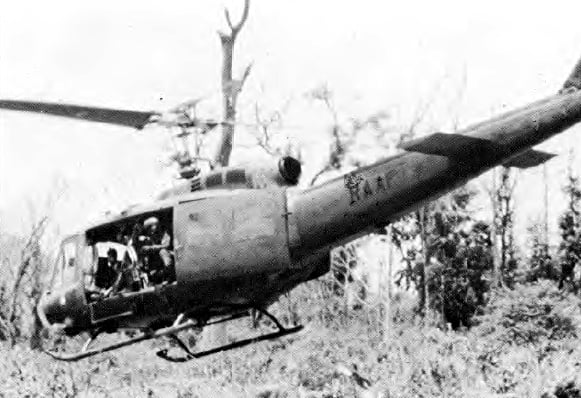
A 9 Sqn UH-1D in Vietnam, 1970
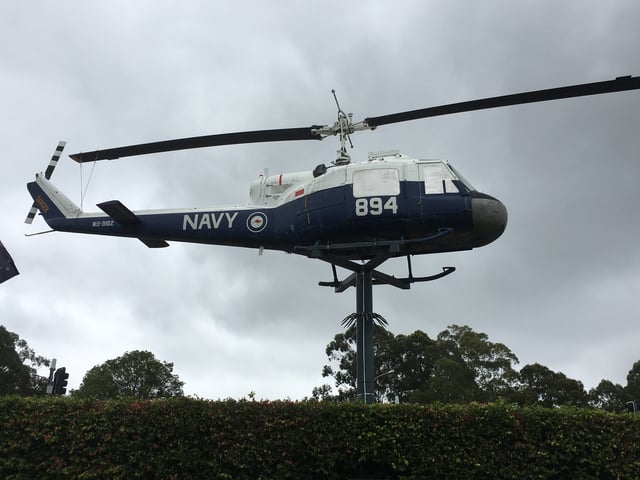
An RAN UH-1B pole-mounted at Nowra
The Royal Australian Air Force employed the UH-1H until 1989. Iroquois helicopters of No. 9 Squadron RAAF were deployed to South Vietnam in mid 1966 in support of the 1st Australian Task Force. In this role they were armed with single M60 doorguns. In 1969 four of No. 9 Squadron's helicopters were converted to gunships (known as 'Bushrangers'), armed with two fixed forward firing M134 7.62 mm minigun (one each side) and a 7-round rocket pod on each side. Aircrew were armed with twin M60 flexible mounts in each door. UH-1 helicopters were used in many roles including troop transport, medevac and Bushranger gunships for armed support.[47] No. 35 Squadron and No. 5 Squadron also operated the Iroquois in various roles through the 1970s and 1980s. Between 1982 and 1986, the squadron contributed aircraft and aircrew to the Australian helicopter detachment which formed part of the Multinational Force and Observers peacekeeping force in the Sinai Peninsula, Egypt.[47] In 1988 the RAAF began to re-equip with S-70A Blackhawks.[47]
In 1989 and 1990 the RAAF's UH-1H Iroquois were subsequently transferred to the 171st Aviation Squadron in Darwin, Northern Territory and the 5th Aviation Regiment based in Townsville, Queensland following the decision that all battlefield helicopters would be operated by the Australian Army.[48] On 21 September 2007, the Australian Army retired the last of their Bell UH-1s. The last flight occurred in Brisbane on that day with the aircraft replaced by MRH-90 medium helicopters and Tiger armed reconnaissance helicopters.[49]
El Salvador
UH-1s were operated by El Salvador Air Force, being at its time the biggest and most experienced combat helicopter force in Central and South America, fighting during 10 years and being trained by US Army in tactics developed during the Vietnam War. UH-1M and UH-1H helicopters used by El Salvador were modified to carry bombs instead of rocket pods.[52]
Germany
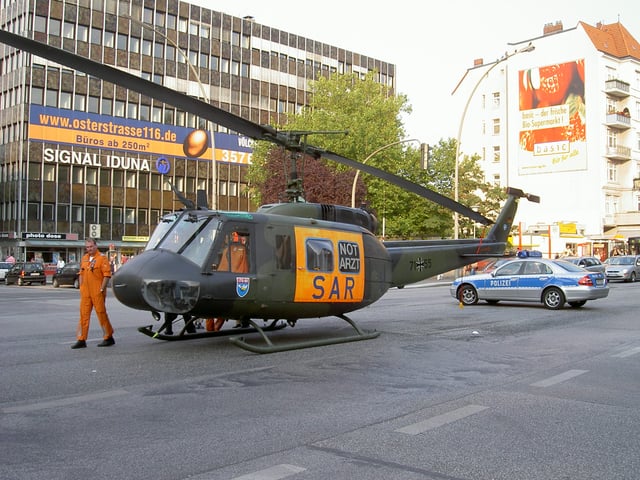
German UH-1D
Dornier built 352 UH-1Ds under license from 1967 to 1981 for the German military (Bundeswehr). These saw service with the German Army and German Air Force as light utility helicopters and as search and rescue (SAR) helicopters.[12]
Israel
Israel withdrew its UH-1s from service in 2002, after thirty three years of service. They were replaced by Sikorsky UH-60 Blackhawk helicopters beginning with an initial batch of 10 delivered in 1994. While some were passed on to pro-Israeli militias in Lebanon, eleven other UH-1Ds were reportedly sold to a Singapore-based logging company but were, instead, delivered in October 1978 to the Rhodesian Air Force to skirt the UN endorsed embargo imposed during the Rhodesian Bush War.[53][54]
Japan
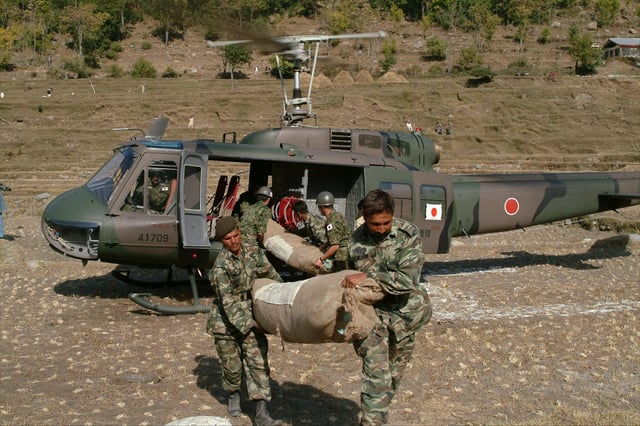
A JGSDF Bell-Fuji UH-1H conducting Kashmir earthquake relief activities (2005)
UH-1s of the Japan Ground Self-Defense Force were deployed for disaster relief after the 2011 Tōhoku earthquake and tsunami, and also conducted reconnaissance over the stricken Fukushima Daiichi Nuclear Power Plant.[58]
Lebanon
During the Battle of Nahr el-Bared camp in North Lebanon, the Lebanese army, lacking fixed-wing aircraft, modified the UH-1H to carry 500 lb (227 kg) Mark 82 bombs to strike militant positions, i.e. helicopter bombing. Special mounts engineered by the Lebanese army were added to the sides of each Huey to carry the high explosive bombs.[61]
New Zealand
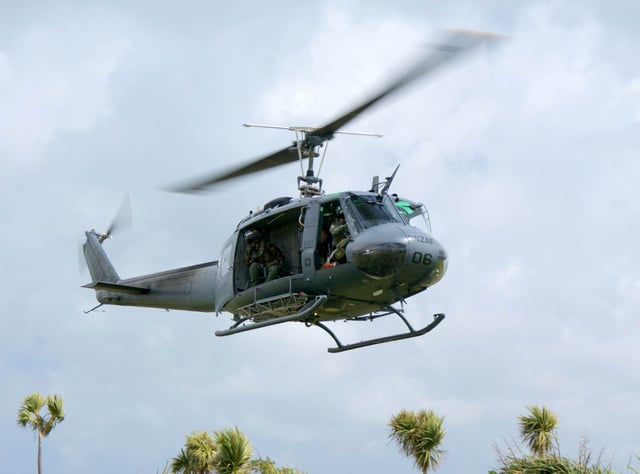
A Royal New Zealand Air Force No. 3 Squadron UH-1H Iroquois, November 2009
The Royal New Zealand Air Force had an active fleet of 13 Iroquois serving with No. 3 Squadron RNZAF.[62] The first delivery was five UH-1D in 1966 followed in 1970 by nine UH-1H and one more UH-1H in 1976. All of the UH-1D aircraft were upgraded to 1H specification during the 1970s. Two ex-U.S. Army UH-1H attrition airframes were purchased in 1996, one of which is currently in service. Three aircraft have been lost in accidents.[63]
The RNZAF is currently in the process of retiring the Iroquois. The NHIndustries NH90 has been chosen as its replacement, eight active NH90 helicopters plus one spare are being procured. This process was initially expected to be completed by the end of 2013, but was delayed until 2016. Individual aircraft were retired as they reach their next major 'group' servicing intervals; the UH-1H is to be retired as the NH90 fleet is stood up.[64] On 21 May 2015, the remaining UH-1H fleet of six helicopters conducted a final tour of the country ahead of its planned retirement on 1 July. During 49 years of service the type had seen service in areas including the U.K., Southeast Asia, Timor, the Solomon Islands, various South Pacific nations, and the Antarctic.[65]
Philippines
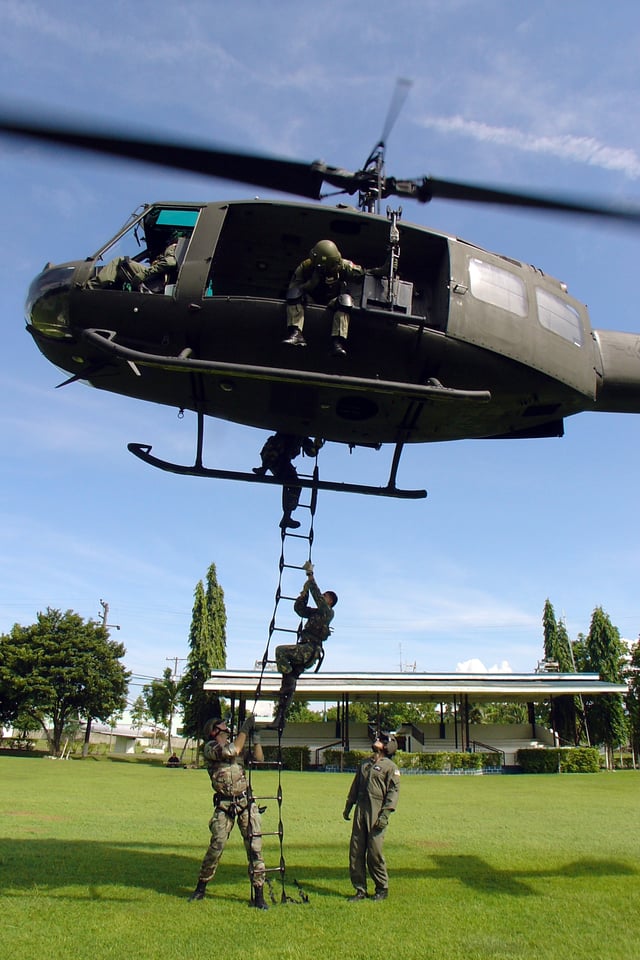
Philippine Air Force Airmen with the 6th SOS unit of the USAF during a bilateral exercise
The Philippine Air Force has a long history of acquiring United States Air Force assets, including Bell UH-1 aircraft. Francis Ford Coppola filmed Apocalypse Now in the Philippines primarily because Ferdinand Marcos agreed to let Coppola use Philippine Hueys to film the iconic scene with Robert Duvall as Lt. Colonel Kilgore.[66]
Rhodesia
Very late in the Rhodesian Bush War the Rhodesian Air Force obtained 11 former Israeli Agusta-Bell 205As,[69] known in service as Cheetahs. After much work these then formed No. 8 Sqn Rhodesian Air Force and took part as troop transports in the counter-insurgency fight. One was lost in combat in September 1979, when hit in Mozambique by a RPG. At least another three were lost. The survivors were put up for sale in 1990.[70]
Yemen
In July 2009, Yemen received four UH-1Hs. These remained grounded for almost all the time they were in Yemen; at least one helicopter was heavily damaged during Saudi-led airstrikes on Al Daylami and Al Anad Air bases.[70]
Variant overview
U.S. military variants
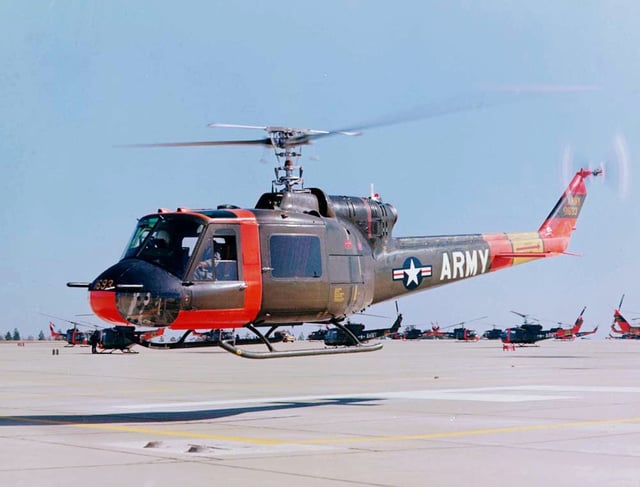
UH-1A Iroquois in flight
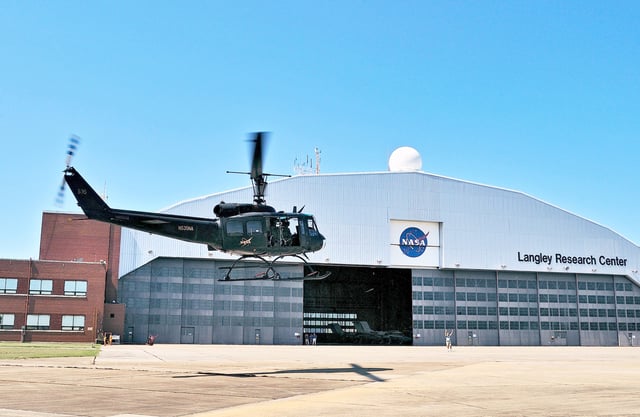
NASA's UH-1H returns to Langley after supporting space shuttle operations at Kennedy Space Center.
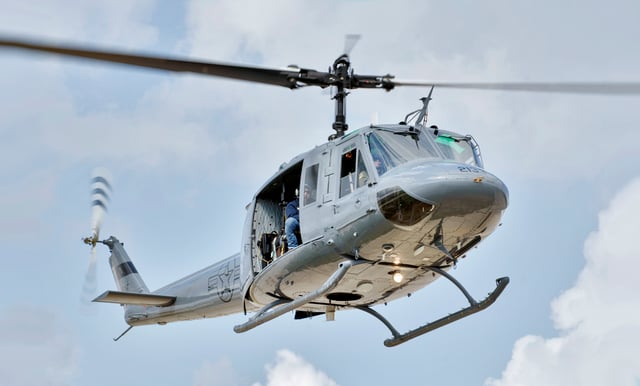
A USAF TH-1H out of Randolph Air Force Base, 2005
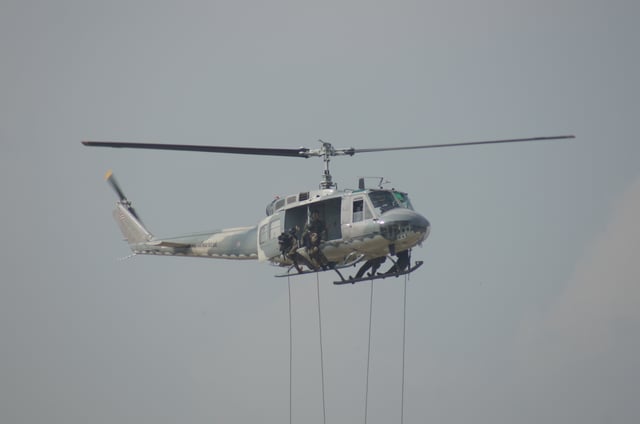
Royal Thai Air Force special operation troops rappel from UH-1 during a demonstration on Children day 2013
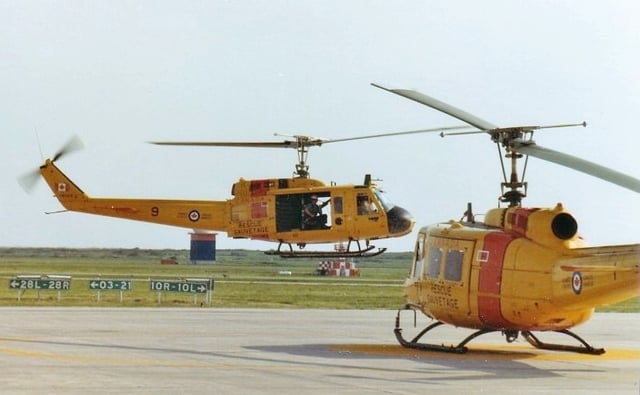
Base Rescue Moose Jaw CH-118 Iroquois helicopters at CFB Moose Jaw, 1982
XH-40: The initial Bell 204 prototype. Three prototypes were built, equipped with the Lycoming XT-53-L-1 engine of 700 shp (520 kW).[17]
YH-40: Six aircraft for evaluation, as XH-40 with 12-inch (300 mm) cabin stretch and other modifications. Bell Model 533: One YH-40BF rebuilt as a flight test bed with turbojet engines and wings.
HU-1A: Initial Bell 204 production model, redesignated as the UH-1A in 1962.[17] 182 built.[71] TH-1A: UH-1A with dual controls and blind-flying instruments, 14 conversions.[71] XH-1A: A single UH-1A was redesignated for grenade launcher testing in 1960.[17]
HU-1B: Upgraded HU-1A, various external and rotor improvements. Redesignated UH-1B in 1962.[17] 1014 built plus four prototypes designated YUH-1B.[71] NUH-1B: a single test aircraft, serial number 64-18261.[17]
UH-1C: The UH-1B gunship lacked the power necessary to carry weapons and ammunition and keep up with transport Hueys, and so Bell designed yet another Huey variant, the "UH-1C", intended strictly for the gunship role. It is an UH-1B with improved engine, modified blades and rotor-head for better performance in the gunship role.[17] 767 built.[71]
YUH-1D: Seven pre-production prototypes of the UH-1D.
UH-1D: Initial Bell 205 production model (long fuselage version of the 204). Designed as a troop carrier to replace the CH-34 then in US Army service.[17] 2008 built many later converted to UH-1H standard.[71] HH-1D: Army crash rescue variant of UH-1D.[17]
UH-1E: UH-1B/C for USMC with different avionics and equipment.[17] 192 built.[71] NUH-1E: UH-1E configured for testing. TH-1E: UH-1C configured for Marine Corps training. Twenty were built in 1965.[17]
UH-1F: UH-1B/C for USAF with General Electric T58-GE-3 engine of 1,325 shp (988 kW).[17] 120 built.[71] TH-1F: Instrument and Rescue Trainer based on the UH-1F for the USAF.[17] 26 built.[71]
UH-1H: Improved UH-1D with a Lycoming T53-L-13 engine of 1,400 shp (1,000 kW).[17] 5435 built.[71] CUH-1H: Canadian Forces designation for the UH-1H utility transport helicopter. Redesignated CH-118.[17][72] A total of 10 built.[71] EH-1H: Twenty-two aircraft converted by installation of AN/ARQ-33 radio intercept and jamming equipment for Project Quick Fix. HH-1H: SAR variant for the USAF with rescue hoist.[17] A total of 30 built.[71] JUH-1: Five UH-1Hs converted to SOTAS battlefield surveillance configuration with belly-mounted airborne radar.[17] TH-1H: Recently modified UH-1Hs for use as basic helicopter flight trainers by the USAF.
HH-1K: Purpose built SAR variant of the Model 204 for the US Navy with USN avionics and equipment.[17] 27 built.[71]
TH-1L: Helicopter flight trainer based on the HH-1K for the USN. A total of 45 were built.[17] UH-1L: Utility variant of the TH-1L. Eight were built.[17]
UH-1M: Gunship specific UH-1C upgrade with Lycoming T53-L-13 engine of 1,400 shp (1,000 kW).[17]
UH-1N: Initial Bell 212 production model, the Bell "Twin Pac" twin-engined Huey powered by Pratt & Whitney Canada T400-CP-400.[17]
UH-1P: UH-1F variant for USAF for special operations use and attack operations used solely by the USAF 20th Special Operations Squadron, "the Green Hornets".[17]
EH-1U: No more than 2 UH-1H aircraft modified for Multiple Target Electronic Warfare System (MULTEWS).[73]
UH-1V: Aeromedical evacuation, rescue version for the US Army.[17]
EH-1X: Ten Electronic warfare UH-1Hs converted under "Quick Fix IIA".[17]
UH-1Y: Upgraded variant developed from existing upgraded late model UH-1Ns, with additional emphasis on commonality with the AH-1Z.
Note: In U.S. service the G, J, Q, R, S, T, W and Z model designations are used by the AH-1. The UH-1 and AH-1 are considered members of the same H-1 series. The military does not use I (India) or O (Oscar) for aircraft designations to avoid confusion with "one" and "zero" respectively.
Other military variants
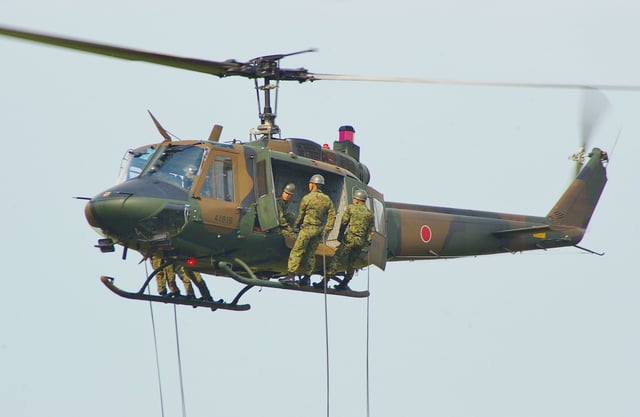
JGSDF UH-1J in Okadama STA, 2007
Bell 204: Bell Helicopters company designation, covering aircraft from the XH-40, YH-40 prototypes to the UH-1A, UH-1B, UH-1C, UH-1E, UH-1F, HH-1K, UH-1L, UH-1P and UH-1M production aircraft. Agusta-Bell AB 204: Military utility transport helicopter. Built under license in Italy by Agusta. Agusta-Bell AB 204AS: Anti-submarine warfare, anti-shipping version of the AB 204 helicopter. Fuji-Bell 204B-2: Military utility transport helicopter. Built under license in Japan by Fuji Heavy Industries. Used by the Japan Ground Self-Defense Force under the name Hiyodori.
Bell 205: Bell Helicopters company designation of the UH-1D and UH-1H helicopters. Bell 205A-1: Military utility transport helicopter version, initial version based on the UH-1H. Bell 205A-1A: As 205A-1, but with armament hardpoints and military avionics. Produced specifically for Israeli contract. Agusta-Bell 205: Military utility transport helicopter. Built under license in Italy by Agusta.
AIDC UH-1H: Military utility transport helicopter. Built under license in Taiwan by Aerospace Industrial Development Corporation.[74]
Dornier UH-1D: Military utility transport helicopter. Built under license in Germany by Dornier Flugzeugwerke.[74]
UH-1G: Unofficial name applied locally to at least one armed UH-1H by the Khmer Air Force in Cambodia.[75] Fuji-Bell 205A-1: Military utility transport helicopter. Built under licence in Japan by Fuji. Used by the Japanese Ground Self Defense Force under the designation HU-1H.[76]
UH-1J: An improved Japanese version of the UH-1H built under license in Japan by Fuji Heavy Industries was locally given the designation UH-1J.[77] Among improvements were an Allison T53-L-703 turboshaft engine providing 1,343 kW (1,800 shp), a vibration-reduction system, infrared countermeasures, and a night-vision-goggle (NVG) compatible cockpit.[78]
Bell 211 Huey Tug With up-rated dynamic system and larger wide chord blades, the Bell 211 was offered for use as the US Army's prime artillery mover, but not taken up.[12]
Bell Huey II: A modified and re-engined UH-1H, improvements were an Allison T53-L-703 turboshaft engine providing 1,343 kW (1,800 shp), a vibration-reduction system, infrared countermeasures, and a night-vision-goggle (NVG) compatible cockpit.significantly upgrading its performance, and its cost-effectiveness. Currently offered by Bell in cooperation with the Philippine Air Force to all current military users of the type.
UH-1/T700 Ultra Huey: Upgraded commercial version, fitted with a 1,400-kW (1900-shp) General Electric T700-GE-701C turboshaft engine.[79]
Operators
Aircraft on display
Accidents
23 July 1982 (1982-07-23): Twilight Zone accident: A Bell UH-1 Iroquois helicopter crashed at Indian Dunes in Valencia, California, during the making of Twilight Zone: The Movie. Actor Vic Morrow and two child actors were killed.
17 January 2018 (2018-01-17): A Sapphire Aviation UH-1H crashed near Raton, New Mexico, United States. Five of the six people on board were killed, including Zimbabwean politician Roy Bennett.
Specifications (UH-1D)
General characteristics
Crew: 1–4
Capacity: 3,880 lb (1,760 kg) including 14 troops, or 6 stretchers, or equivalent cargo
Length: 57 ft 1 in (17.40 m) with rotors
Width: 8 ft 7 in (2.62 m) (Fuselage)
Height: 14 ft 5 in (4.39 m)
Empty weight: 5,215 lb (2,365 kg)
Gross weight: 9,040 lb (4,100 kg)
Max takeoff weight: 9,500 lb (4,309 kg)
Powerplant: 1 × Lycoming T53-L-11 turboshaft, 1,100 shp (820 kW)
Main rotor diameter: 48 ft 0 in (14.63 m)
Performance
Maximum speed: 135 mph (220 km/h, 117 kn)
Cruise speed: 125 mph (205 km/h, 109 kn)
Range: 315 mi (510 km, 274 nmi)
Service ceiling: 19,390 ft (5,910 m) dependent on factors such as weight, air temperature, etc
Rate of climb: 1,755 ft/min (8.9 m/s)
Power/mass: 0.15 hp/lb (0.25 kW/kg)
Armament various including:
7.62 mm machine guns
2.75 in (70 mm) rocket pods
Notable appearances in media
The image of American troops disembarking from a Huey has become an iconic image of the Vietnam War, and can be seen in many films, video games and television shows on the subject, as well as more modern settings. The UH-1 is seen in many films about the Vietnam War, including The Green Berets, The Deer Hunter, Platoon, Hamburger Hill, Apocalypse Now,[66] Casualties of War, and Born on the Fourth of July. It is prominently featured in We Were Soldiers as the main helicopter used by the Air Cavalry in the Battle of Ia Drang. Author Robert Mason recounts his career as a UH-1 "Slick" pilot in his memoir, Chickenhawk.
The 2002 journey of "Huey 091", displayed in the Smithsonian National Museum of American History, is outlined in the documentary In the Shadow of the Blade.[80]
See also
Bell Huey – overview of all models
Related development
Bell AH-1 Cobra
Bell AH-1 SuperCobra
Bell UH-1N Twin Huey
Bell UH-1Y Venom
Bell 204/205
Bell 212
Bell 214
Bell 412
Bell 533
Panha Shabaviz 2-75
Aircraft of comparable role, configuration and era
Sikorsky XH-39
Related lists
List of active United States military aircraft